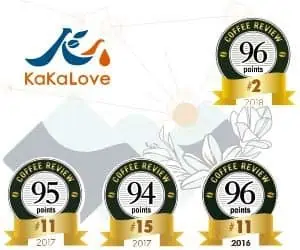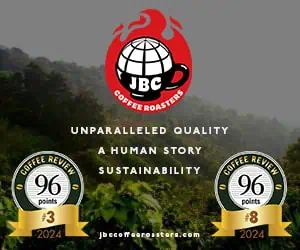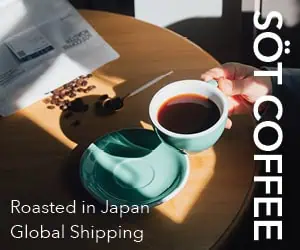Top-Rated Coffees (94+ points)
We found 2188 coffees and espressos that earned an outstanding score of 94 points or higher. The reviews below appear in reverse chronological order by review date. Older reviews may no longer accurately reflect current versions of the same coffee.
Buttery aroma: nut, flowers, dry berry. Rich acidity, medium body. The elegantly pungent berry note cuppers call black currant dominates in the cup, but supported by a profound underlying sweetness that gives the berry a dark chocolate depth. Flowers revive in the fine, rich, flavor-saturated finish.
Symphonically rich coffee of extraordinary elegance. Crisp dry berry notes of the kind often characterized as black currant, orange, nut, dusk flowers run through the profile from aroma to cup. Powerful acidity enveloped in sweetness, lightly syrupy mouthfeel. The black currant notes in particular carry into a long, pure, sweet-toned finish.
Balanced, complex, complete. The quiet but assertive acidity was praised as "balanced" by co-cupper Ted Stachura (93) and "sweet, rich, integrated" by Ken (94). The mouthfeel was "juicy" (Ted), the aroma and cup showed a crisply sweet complex of dry berry, cocoa, flowers, citrus, nut. Long, deep, chocolate-toned finish.
Big, deep, classically symphonic coffee. Intense aroma: black-cherryish fruit, white wine, flowers. In the cup syrupy body, powerful but rounded acidity, pungently juicy flavor with sweet lemon and night flower notes. Pure, smooth, fruit-and-flower saturated finish.
Intense aroma: ripe, fallen fruit, flowers, flowering grass, honey, pungent cedar. In the cup fruit-deepened acidity, syrupy mouthfeel, roundly sweet with a mild, balancing bitterness and tremendous aromatic complexity: honey, night flowers, and above all a brandyish, fruity chocolate that carries deep into the finish.
Crisp but juicy in the aroma, with butter, honey, flower and marmalade-like orange notes. In the cup smoothly and gently acidy, delicate in mouthfeel, with a continued tart, marmalade-like, orangy sweetness complicated by cocoa, cedar, and continued flower and honey notes. Oranges and flowers carry into a cleanly sweet finish.
Grand-gestured, complete coffee. Intense, rose-like floral notes dominate the aroma, with lush honey, molasses and coffee fruit. In the cup the mouthfeel has honeyish depth, the acidity is sweetly powerful, the flavor dominated by tart berry notes both dryly austere yet utterly and voluptuously juicy, complicated by continued honey, molasses and flowers. Smooth, balanced, flower-saturated finish.
Powerfully sweet throughout the profile, but without candyish sentiment. Moist leafy earth notes in the aroma with hints of flowers and grapefruit and pungently buttery notes that plausibly read as butterscotch. In the cup big-bodied with a backgrounded but vibrant acidity. Flavor is dominated by a lush, cherryish or grapey fruit with continuing hints of earth and butterscotch. The lush fruit and crisp earth together carry into the long, deep finish.
Sweet-toned, delicately complex aroma: flowers, hints of honey, cedar and tart cherry, perhaps chocolate. In the cup very gently acidy, light in body but buoyant and silky in mouthfeel, and giddily floral- and honey-toned with complicating hints of chocolate, tart coffee fruit and Riesling-like white wine. Fades rather quickly in the finish but exquisitely clean with memories of chocolate and flowers. An exceptionally pure and balanced coffee.
Intense, balanced aroma: cedar, cherry, flowers, orange. In the cup syrupy body with an almost bouillon-like richness, deeply but quietly acidy, with floral high notes and a wonderfully deep cherry- and cedar-toned chocolate. The pungent chocolate/fruit notes carry into a long, flavor-saturated finish.
Sweet-toned, quiet aroma with nut, dried cherry and chocolate. Elegantly balanced cup: softly acidy, silky in mouthfeel, with continued dried cherry, cocoaish chocolate and a slight brightening hint of lemon. The chocolate notes in particular carry into the long, rich, complex finish.
Deep-toned aroma with great range and complexity: flowers, orange, cocoa, butter, cedar. In the cup richly acidy, medium in body, silky in mouthfeel, with continued lavender-like floral notes, crisp cocoa, dry berry. Clean, tartly juicy finish with flower notes present to the last fading.
Delicately but richly nuanced throughout the profile with cherryish fruit, flowers, honey, milk chocolate. In the cup the acidity is tart but luxuriously sweet and the mouthfeel lightly syrupy. Flavor saturated and flawless finish.
Crisp, intense, yet sweetly lyric coffee. In both aroma and cup black currant, blackberry, orange, cherry; in the cup hints of cocoaish chocolate and merlot-like red wine as well. Long, sweet finish just on the rich side of astringent.
Sweet-toned, quietly intense aroma: jasmine, sweet citrus, cocoa. In the cup the mouthfeel is silky, almost syrupy, the acidity intense but delicate with shimmers of white wine. Orange, lemon, cocoaish chocolate, floral notes. Long, deep, flavor-saturated finish.
Intense, exuberantly complex aroma: orange, grapefruit, honey, cedar, black currant. In the cup the acidity is intense and sweet, the mouthfeel syrupy, the flavor continuingly complex, dry yet lush: black currant, grapefruit, wine, a hint of milk chocolate. The finish is superb: saturated with grapefruit and chocolate, sweet, rich, long.
Intense, sweetly tart aroma: flowers, cherry, lemon. In the cup the acidity is lyrically sweet, the mouthfeel silky, the flavor vivid with grapefruit, dry berry and floral notes that soften toward a raisiny chocolate as the cup cools. Superb finish: cleanly bright, long, sweet to the far end of sensation.
The aroma is very deep and sweet-toned with lush references to banana, coconut, dusk flowers. In the cup the acidity is extraordinarily rich and round-toned, the mouthfeel supple, the nuance opulent with coconut, red wine, chocolate and floral notes. Rich, long, flavor-saturated finish.
Lush, deeply fruity aroma: chocolate and red-wine-toned cherry. In the cup silky mouthfeel, richly balanced acidity, lavish cocoa, candied lemon, red wine, brandied cherry notes. Deep, flavor-saturated finish.
High-toned, intense aroma with striking lemon, chocolate and menthol notes and a hint of flowers. In the cup softly and sweetly acidy with a lovely balance and distinct bittersweet chocolate and lemon notes. Superb finish: rich, crisp, saturated with a dry chocolate.















